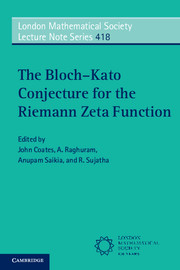Book contents
- Frontmatter
- Contents
- List of contributors
- Preface
- 1 Special Values of the Riemann Zeta Function: Some Results and Conjectures
- 2 K-theoretic Background
- 3 Values of the Riemann Zeta Function at the Odd Positive Integers and Iwasawa Theory
- 4 Explicit Reciprocity Law of Bloch–Kato and Exponential Maps
- 5 The Norm Residue Theorem and the Quillen-Lichtenbaum Conjecture
- 6 Regulators and Zeta-functions
- 7 Soulé's Theorem
- 8 Soulé's Regulator Map
- 9 On the Determinantal Approach to the Tamagawa Number Conjecture
- 10 Motivic Polylogarithm and Related Classes
- 11 The Comparison Theorem for the Soulé–Deligne Classes
- 12 Eisenstein Classes, Elliptic Soulé Elements and the ℓ-Adic Elliptic Polylogarithm
- 13 Postscript
- References
9 - On the Determinantal Approach to the Tamagawa Number Conjecture
Published online by Cambridge University Press: 05 March 2015
- Frontmatter
- Contents
- List of contributors
- Preface
- 1 Special Values of the Riemann Zeta Function: Some Results and Conjectures
- 2 K-theoretic Background
- 3 Values of the Riemann Zeta Function at the Odd Positive Integers and Iwasawa Theory
- 4 Explicit Reciprocity Law of Bloch–Kato and Exponential Maps
- 5 The Norm Residue Theorem and the Quillen-Lichtenbaum Conjecture
- 6 Regulators and Zeta-functions
- 7 Soulé's Theorem
- 8 Soulé's Regulator Map
- 9 On the Determinantal Approach to the Tamagawa Number Conjecture
- 10 Motivic Polylogarithm and Related Classes
- 11 The Comparison Theorem for the Soulé–Deligne Classes
- 12 Eisenstein Classes, Elliptic Soulé Elements and the ℓ-Adic Elliptic Polylogarithm
- 13 Postscript
- References
Summary
Abstract
We give a survey of Fontaine and Perrin-Riou's formulation of the Tamagawa number conjecture on special values of the L-functions of motives in terms of determinants and Galois cohomology. Following Fontaine's Bourbaki talk, we show its equivalence with the original formulation of Bloch–Kato. As an illustration, we sketch a proof for the Dedekind zeta function of an abelian number field.
The conjecture of Bloch and Kato [BK90] on the special values of the L-functions of motives was originally expressed – in analogy with the theory of semi-simple algebraic groups – in terms of Haar measures and Tamagawa numbers. Hence its usual other name, the Tamagawa number conjecture (TNC for short), to which we shall stick in these notes, in order to avoid confusion with another Bloch–Kato conjecture (on K-theory and Galois cohomology; see [Ko15] in this volume). Later on, Fontaine and Perrin-Riou [FPR94] proposed another formulation in terms of determinants of perfect complexes and Galois cohomology. Although the arithmetic becomes less apparent in the new formalism, it allows more flexibility and generality, as illustrated for instance by the subsequent development of the equivariant version of the conjecture (ETNC for short), which ‘provides a coherent overview and refinement of many existing “equivariant” conjectures, including for example the refined Birch–Swinnerton-Dyer conjecture for CM elliptic curves formulated by Gross, the conjectural congruences of Dirichlet L-functions formulated by Gross and Tate, the conjectures formulated by Chinburg et al. in the area of Galois module theory’ (see [BG03, Introduction, p.303]). As for the TNC proper, Fontaine and Perrin-Riou note that ‘the complicated formulas bringing in Tamagawa numbers, orders of Shafarevich groups, are only the consequence of the explicit calculation of an “intrinsic” formula making use of certain Euler–Poincaré characteristics’ [FPR94, p. 600]. Being among the arithmeticians who regret the occultation of these ‘complicated formulas’ in the style of the analytic class number formula, we were too happy to accept the proposal of the organizers of the Pune workshop to write these notes on the comparison and (at least when the field of coefficients is ℚ) the equivalence between the two formulations, that of Bloch–Kato and that of Fontaine–Perrin-Riou.
- Type
- Chapter
- Information
- The Bloch–Kato Conjecture for the Riemann Zeta Function , pp. 154 - 192Publisher: Cambridge University PressPrint publication year: 2015

